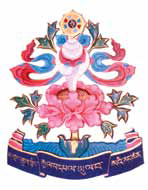The organization that Her Eminence Jetsunma Ahkon Lhamo Rinpoche founded as the World Prayer Center in 1985 has been known since 1988 by the name that Penor Rinpoche conferred, Kunzang Odsal Palyul Changchub Choling (KPC), with Jetsunma as the Spiritual Director.
The Palyul Lineage

The seal of the Palyul Lineage in the Nyingmapa tradition.
Since her recognition and enthronement, Jetsunma has guided the center’s transition to a more conventional Vajrayana Buddhist path following the Palyul monastic tradition. Toward that end, she has hosted all of the major lamas from Palyul Monastery, as well as many others from the Nyingma and Kagyu schools, to give the traditional transmissions and commentaries. In April 1985, Jetsunma and her students began the 24 Hour Prayer Vigil at KPC, dedicated to the end of suffering for all sentient beings. The Prayer Vigil continues unbroken to the present day.

Palyul - Tibet
The Palyul Monastery was built by Lhachen Jampa Phuntsog, the first Dharma King of Dege. It was constructed on a site which possesses all the essential auspicious signs and had been blessed by the presence of many great mahasiddhas. In a prophecy from the treasure revealer Sang-ngag Lingpa, it is written of Palyul,
“The rocks clearly display self-originating images of Vajrapani as well as blue HUNG syllables with radiating flames. Both the unsurpassed practice cave of Yeshe Tsogyal and the Secret Accomplishment cave of Padmasambhava are located there…At Namtsong rock (located in front of the Palyul monastery) thirteen secret termas have been concealed.”
It was at this excellent place that the founding father, Kunzang Sherab, made his spiritual seat. Penor Rinpoche writes:
“The land the monastery is situated upon was blessed by the presence of many great bodhisattvas, dating back to the time of the three great dharma kings…In accordance with the ripening of past prayers, the Vidyadhara Kunzang Sherab later came to stay at the monastery. It was at this time that the Palyul tradition was established and the monastery named Palyul Namgyal Changchub Chöling became one of the major Nyingmapa monastic institutions.”
Source: Palyul Ling International
Visit to Paiyul / Palyul / Baiyu monastery created in 1675,
which is one of the three biggest monasteries of Nyingmapa-sect in Tibetan Kham area.
HH Penor Rinpoche Returns to Palyul
In 1982 Penor Rinpoche returned to Palyul for the first time after leaving Tibet and visited the main Palyul Monastery and many of its branch monasteries. Thousands came to receive the blessings, empowerments and teachings which he bestowed. He ordained over 500 monks and made generous offerings to the members of the sangha. He also gave donations to support the reconstruction of the monastery.
After that 1982 visit, he continued to return to Tibet several times, overseeing the reconstruction work as well as giving teachings, empowerments and transmissions. In 1994 he reestablished Palyul’s monastic institute with over 140 students enrolled in the study program there. Today there are over 300 monks in residence at the Palyul Monastery in Tibet.

Namdroling - India
Namdroling Monastery represents the fruit of the huge investment of time and energy made by Penor Rinpoche. Today, Namdroling Monastery in Byalakuppe is a thriving community and home to thousands of lamas, monks and nuns, making it the largest Nyingmapa teaching center in the world. Those who have studied or are studying at the monastery include all the major lineage holding tulkus and lamas of the Palyul tradition, including the fifth Karma Kuchen Rinpoche, the third Chögtrul Rinpoche and the third Rago Chögtrul Rinpoche. Their spiritual training is directed by guidance left by Penor Rinpoche himself. Tulkus of other traditions have also studied at Namdroling, including the Sakyong (Mipham Rinpoche), Minling Dungsey, and Minling Khenchen Rinpoche.
Palyul never turns away anyone who is qualified to join the monastic sangha. All the expenses required to live and study at the monastery are borne by Palyul. These include housing, food, medical care, clothing and even pocket money for all the monks and nuns.
It is said that those who have command over their mind can also command the physical elements. Penor Rinpoche wrote in ink on a conch shell, this time the mantra of Manjushri, the bodhisattava of wisdom. Even when the ink had faded the letters remained luminously embossed on the conch, which is still kept and cherished by Khenpo Namdrol. This was recognized as a sign that the tradition of Nyingma scholars would flourish and continue at Namdroling.
Source: Palyul Ling International
KPC Maryland Updates
 COVID-19 RESPONSE
COVID-19 RESPONSE
Read our response - keeping you safe
 VIRTUAL TEMPLE
VIRTUAL TEMPLE
Join us in the Virtual Temple
 CAPITAL CAMPAIGN
CAPITAL CAMPAIGN
Temple renovation news...
Join Our Mailing List
Copyright - All rights reserved
May all sentient beings be free of suffering


